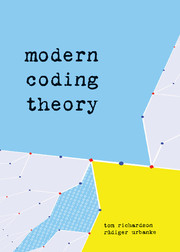Book contents
- Frontmatter
- Contents
- PREFACE
- 1 INTRODUCTION
- 2 FACTOR GRAPHS
- 3 BINARY ERASURE CHANNEL
- 4 BINARY MEMORYLESS SYMMETRIC CHANNELS
- 5 GENERAL CHANNELS
- 6 TURBO CODES
- 7 GENERAL ENSEMBLES
- 8 EXPANDER CODES AND FLIPPING ALGORITHM
- A ENCODING LOW-DENSITY PARITY-CHECK CODES
- B EFFICIENT IMPLEMENTATION OF DENSITY EVOLUTION
- C CONCENTRATION INEQUALITIES
- D FORMAL POWER SUMS
- E CONVEXITY, DEGRADATION, AND STABILITY
- Authors
- Index
7 - GENERAL ENSEMBLES
Published online by Cambridge University Press: 05 September 2012
- Frontmatter
- Contents
- PREFACE
- 1 INTRODUCTION
- 2 FACTOR GRAPHS
- 3 BINARY ERASURE CHANNEL
- 4 BINARY MEMORYLESS SYMMETRIC CHANNELS
- 5 GENERAL CHANNELS
- 6 TURBO CODES
- 7 GENERAL ENSEMBLES
- 8 EXPANDER CODES AND FLIPPING ALGORITHM
- A ENCODING LOW-DENSITY PARITY-CHECK CODES
- B EFFICIENT IMPLEMENTATION OF DENSITY EVOLUTION
- C CONCENTRATION INEQUALITIES
- D FORMAL POWER SUMS
- E CONVEXITY, DEGRADATION, AND STABILITY
- Authors
- Index
Summary
In practical LDPC design one is invariably interested in achieving the best possible performance. Although we have used the framework of irregular low-density parity-check (LDPC) ensembles throughout this book, the notion of “irregularity” we have employed is not the most general possible and the best performing structures are not properly captured in that framework.
We start by presenting in Section 7.1 a generalization of irregular LDPC ensembles called multi-edge-type LDPC ensembles. In principle, any of the ensembles suggested to date can be represented in this form and we demonstrate this discussing a few examples.
In Section 7.2 we review the theory surrounding these ensembles. It is largely the same as for the standard irregular case, which is why we have avoided using this more complex notion so far. The multi-edge-type generalization enjoys several advantages. With multi-edge-type LDPC codes one can achieve better performance at lower complexity. The generalization is especially useful under extreme conditions where standard irregular LDPC codes do not fare so well. Examples of these conditions include very low code rates, high rate codes that target very low bit error rates, and codes used in conjunction with turbo equalization schemes.
We discuss in Section 7.3 an alternative and complementary way of describing structured ensembles. These ensembles are the result of lifting a very small graph to a large graph by first replicating the structure of the small graph a large number of times and then by choosing the connections between these copies in a random way.
- Type
- Chapter
- Information
- Modern Coding Theory , pp. 381 - 426Publisher: Cambridge University PressPrint publication year: 2008



